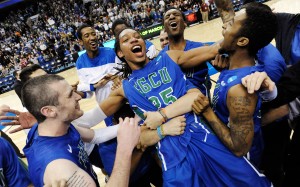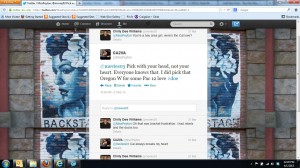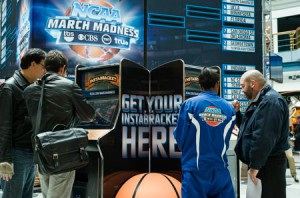It’s tourney time! Since 1939 (Bachman, 2012) when 8 teams battled for the top spot, Division I men’s basketball has dominated springtime sports and the hearts of millions of Americans as now, 68 teams battle single-elimination in search of their “one shining moment”. I can remember being 11 years old the first time my dad let me stay home from school for Round 1 of the tournament to overdose on 24 hours of basketball in 2 days. I can remember last year when I moved my laptop from my office to the board room and hooked it up to the projector to watch the noon games on livestream. What I have a harder time remembering is exactly when the tournament became such a marketing juggernaut!
me stay home from school for Round 1 of the tournament to overdose on 24 hours of basketball in 2 days. I can remember last year when I moved my laptop from my office to the board room and hooked it up to the projector to watch the noon games on livestream. What I have a harder time remembering is exactly when the tournament became such a marketing juggernaut!
With almost 150 hours of televised exposure, throngs of sponsors like Allstate, Buick, Enterprise Rent A Car, Dominoes pizza, and countless other companies are hopping onto the advertising and marketing train to capitalize on multi-network exposure and continuous viewership. In the past decade, March Madness is everywhere. We’ve seen a concerted effort to connect and blend content across media, and a marked increase in user-generated content to push the marketing. Basketball fans (the TV networks would certainly call them consumers) are engaged at virtually every media touchpoint over the four-week tournament. Games on TV, streaming game coverage, bracket competitions on the internet, apps on mobile devices , user-generated content on and twitter and facebook, merchandising through retail outlets, the engagement is endless. Though only for a limited amount of time each year, March Madness marketing has mastered seamless marketing integration.
Integration of media has opened up March Madness to new and  younger markets previously difficult to reach. In the past, marketers focused on the large alumni (read: adult) population that tunes in every year. Kids are normally in school for the first 2 days. Twitter, Facebook, and Instagram have opened the doors to a younger, social media market who is receptive to digital marketing in a way that their older counterparts aren’t. The cost-saving implications of launching social media campaigns on free web platforms instead of relying heavily on expensive television advertising aren’t lost on marketing teams, and the shift is evident. I got my first March Madness email on March 12th. Before Selection Sunday even determined who would be playing in the tournament. A subtle reminder from CBSSports to start gathering my troops for my annual bracket pool.
younger markets previously difficult to reach. In the past, marketers focused on the large alumni (read: adult) population that tunes in every year. Kids are normally in school for the first 2 days. Twitter, Facebook, and Instagram have opened the doors to a younger, social media market who is receptive to digital marketing in a way that their older counterparts aren’t. The cost-saving implications of launching social media campaigns on free web platforms instead of relying heavily on expensive television advertising aren’t lost on marketing teams, and the shift is evident. I got my first March Madness email on March 12th. Before Selection Sunday even determined who would be playing in the tournament. A subtle reminder from CBSSports to start gathering my troops for my annual bracket pool.
Ah, the brackets…this year ESPN reported over 8 million registered online brackets in competition. There were no perfect brackets left by the end of day 2 (thanks, Georgetown). This news spread through twitter like wildfire, much like the news that Florida Gulf Coast University existed, played basketball, and could beat top tier programs like Georgetown and San Diego State. A platform like twitter is perfect for every fan to live out their sports commentator fantasies (self included) and thanks to integration with major networks, websites and mobile applications, every thought is a tweet heard ‘round the world. Twitter erupted with questions and speculations of what a busted bracket could mean for the nation. Wanna know how I know? CBSSports runs a twitter pulse at the bottom of their life scoretracker webpage. Right. I can get a feel for twitter activity by watching my televised basketball on the internet.
What about those who want to join in the office fun of a bracket pool but haven’t seen a single minute of basketball this year? You’re covered there too. Seemingly on demand, these bracket generators popped-up outside Madison Square Garden, Union Stations in Chicago and DC, Liberty Place in Philly, and the Highland Cetner in LA. the day after Selection Sunday. I can tell the machine to make picks with “minimal upsets” or “highest seed winners” and voila…my bracket completed with little to no actual basketball knowledge of my own. Oh…and it’s free.
outside Madison Square Garden, Union Stations in Chicago and DC, Liberty Place in Philly, and the Highland Cetner in LA. the day after Selection Sunday. I can tell the machine to make picks with “minimal upsets” or “highest seed winners” and voila…my bracket completed with little to no actual basketball knowledge of my own. Oh…and it’s free.
Aside from my deep personal connection to the world of college sports, March Madness has branded itself as a unifying, can’t-miss month is our lives. Bringing together coworkers, dads and daughters, and strangers, March Madness marketing has tapped into our emotions, our competitive spirits and our need to always be plugged in. Genius. Absolutely genius.
One last confession, I totally still cry every year when One Shining Moment plays. Don’t judge me.
Bachman, R. (March 17, 2012). Where was the bracket born?. Wall Street Journal. Retrieved from: http://online.wsj.com/article/SB10001424052702304537904577279624141400742.html
Barrett, D. (1987). One shining moment [Recorded by Luther Vandross).
Buss, D. (March 8, 2012). Brands tap into NCAA March Madness. Brand Channel. Retrieved from: http://www.brandchannel.com/home/post/2012/03/08/march-madness-brands-030812.aspx
Lawler, R. (March 16, 2013). March Madness live apps are free this year, stream all the games–if you have cable. Engadget. Retrieved from: http://www.engadget.com/2013/03/16/march-madness-live-apps-are-free-this-year-stream-all-the-games/
TW Staff. (2013, March 13). Let the NCAA bracketmania begin [Web log post]. Retrieved from http://www.timewarner.com/blog/posts/20130320-Let-the-NCAA-Bracketmania-Begin/

12 Responses to Bracket Busting is Big Business: Integrated Marketing and the Big Dance